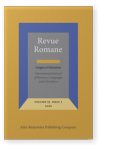Vol. 55:1 (2020) ► pp.138–163
Traduction et réécriture dans les textes hétérolingues
L’exemple de Larva. Babel de una noche de San Juan (1983) de Julián Ríos
This article investigates the role of translation and rewriting in Julián Ríos’s first novel Larva. Refusing to be read in a linear manner, including thousands of plays-on-words and more than 20 languages besides Spanish, Larva breaks many linguistic, literary and discursive codes. It also displays close links with translation as it constantly moves from one language to another. The influence of translation and rewriting in the novel is analyzed from contemporary approaches to Ríos’s views on literature (e.g. Kristeva, Riffaterre) with an aim of understanding how they shape Larva’s main narrative structures and writing processes. Finally, the case of Larva leaves the door open for questioning the principles of originality and creation in (heterolingual) literature.
Article outline
- Introduction
- 1.Le projet de Larva
- 2.Le paradigme traductif en littérature : traduire, un préalable du dire
- 2.1La traduction dans le dispositif narratif de Larva
- 2.1.1Traduction et réécriture dans le fonctionnement narratif
- 2.1.2Babelle, Milalias et alii : Des personnages lost in translation
- 2.1.3La traduction comme négociation de l’hétérolinguisme et comme jeu d’écriture
- 2.2Au-delà des jeux de traduction, une mise en scène de la traductibilité des langues
- 2.1La traduction dans le dispositif narratif de Larva
- Conclusion
- Remarques
-
Bibliographie
Article language: French
